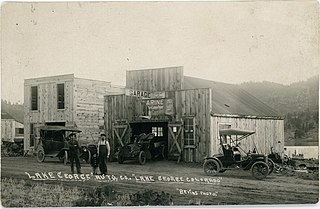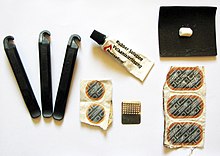
A bicycle, also called a pedal cycle, bike, push-bike or cycle, is a human-powered or motor-powered assisted, pedal-driven, single-track vehicle, having two wheels attached to a frame, one behind the other. A bicycle rider is called a cyclist, or bicyclist.

The technical meaning of maintenance involves functional checks, servicing, repairing or replacing of necessary devices, equipment, machinery, building infrastructure, and supporting utilities in industrial, business, and residential installations. Over time, this has come to include multiple wordings that describe various cost-effective practices to keep equipment operational; these activities occur either before or after a failure.

A mechanic is a skilled tradesperson who uses tools to build, maintain, or repair machinery, especially cars.

A survival kit is a package of basic tools and supplies prepared as an aid to survival in an emergency. Civil and military aircraft, lifeboats, and spacecraft are equipped with survival kits.
Integrated logistics support (ILS) is a technology in the system engineering to lower a product life cycle cost and decrease demand for logistics by the maintenance system optimization to ease the product support. Although originally developed for military purposes, it is also widely used in commercial customer service organisations.
The United States Army divides supplies into ten numerically identifiable classes of supply. The North Atlantic Treaty Organization (NATO) uses only the first five, for which NATO allies have agreed to share a common nomenclature with each other based on a NATO Standardization Agreement (STANAG). A common naming convention is reflective of the necessity for interoperability and mutual logistical support.
A run-flat tire is a pneumatic vehicle tire designed to resist the effects of deflation when punctured, allowing the vehicle to continue to be driven at reduced speeds for limited distances. First developed by tire manufacturer Michelin in the 1930s, run-flat tires were introduced to the public market in the 1980s. They have increased in popularity over time.

An automobile repair shop is an establishment where automobiles are repaired by auto mechanics and technicians. The customer interface is typically a service advisor, traditionally called a service writer.

A flat tire is a deflated pneumatic tire, which can cause the rim of the wheel to ride on the tire tread or the ground potentially resulting in loss of control of the vehicle or irreparable damage to the tire. The most common cause of a flat tire is puncturing of the tire by a sharp object, such as a nail or pin, letting the air escape. Depending on the size of the puncture, the tire may deflate slowly or rapidly.
Hiking equipment is the equipment taken on outdoor walking trips. Hiking is usually divided into day-hikes and multiple-day hikes, called backpacking, trekking, and walking tours.

A continental tire or a continental kit is a term used in the United States for an upright externally-mounted spare tire located behind an automobile's trunk, made popular by the Continental Mark Series, which carried a simulated continental tire until 1998.
A tubeless tire is a pneumatic tire that does not require a separate inner tube.

A spare tire is an additional tire carried in a motor vehicle as a replacement for one that goes flat, has a blowout, or has another emergency. Spare tire is generally a misnomer, as almost all vehicles actually carry an entire wheel with a tire mounted on it as a spare rather than just a tire, as fitting a tire to a wheel would require a motorist to carry additional, specialized equipment. However, some spare tires are not meant to be driven long distances. Space-savers have a maximum speed of around 50 mph (80 km/h).
In the United States, with regard to automobiles, a glider is a vehicle without a powertrain. Gliders are generally sold as unused car bodies, but a second-hand car may also be stripped of its powertrain and sold as a glider. The purpose of such a vehicle is to be used as a base for a non-standard powertrain, to create a novel variation of a conventional vehicle, custom car, exotic vehicle, or homemade electric vehicle conversion. The term is analogous to an aircraft with no engine being a glider.

A tubular tyre, referred to as a tub in Britain, a sew-up in the US, a single in Australia, or just a tubular is a bicycle tyre that is stitched closed around the inner tube to form a torus. The combination is then glued onto a specially designed rim, referred to as a "sprint rim" in Britain, and just a "tubular rim" in the US, of a bicycle wheel.

A car's internal costs are all the costs consumers pay to own and operate a car. Normally these expenditures are divided into fixed or standing costs and variable or running costs. Fixed costs are those which do not depend on the distance traveled by the vehicle and which the owner must pay to keep the vehicle ready for use on the road, like insurance or road taxes. Variable or running costs are those that depend on the use of the car, like fuel or tolls.

An Engineer Light Ponton Company was a combat engineer company of the United States Army that served with U.S. Army ground forces during World War II. It was primarily a highly mobile pontoon bridge construction unit, though it also provided both M2 assault boats and a selection of infantry support bridging, ferries, and rafts.














